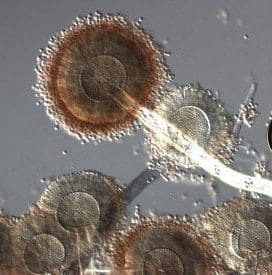
Get A Testing Quote
Botrytis cinerea
STRUCTURE AND PHYSIOLOGY
Botrytis cinerea, also known as gray mold, is a primarily anamorphic, necrotrophic fungi that is primarily found on injured plant tissues and in damp places around homes and gardens. The microorganism thrives at temperatures between 22°C and 25°C with an 85% relative humidity or higher. Botrytis cinerea has developed many genotypic and phenotypic variations that has allowed it to adapt to and affect approximately 1000 species of plants, including strawberries, raspberries and grapes, giving it a substantial ecological impact.
TRANSMISSION AND DISEASE
Primarily a plant pathogen, Botrytis cinerea can affect almost every part of the plant it infects and cause both pre-and post-harvest losses in many agricultural vegetables and fruits. In humans Botrytis cinerea may cause a rare allergic reaction called “Winegrower’s lung” in those predisposed to it.
DISINFECTION
Due to the large variation shown by this fungus, there are several fungicide-resistant strains that make it a focus of agricultural research to prevent further economic losses.
UNIQUE OR INTERESTING FACT
Botrytis cinerea is occasionally used in wine making as a controlled infection dehydrates some grapes – increasing sugar concentration, and leading to a uniquely flavored, sweeter wine. When used in this capacity, Botrytis cinerea is often referred to as “noble rot”.
REFERENCES
Ward, J. “Botrytis: Species, Effects and Treatment.” Mold Busters (2022). Available at: Botrytis: Species, Effects and Treatment | Mold Busters (bustmold.com) (Accessed: 12th May 2022)
Li Hua, Chen Yong, Zhang Zhanquan, Li Boqiang, Qin Guozheng, Tian Shiping, Pathogenic mechanisms and control strategies of Botrytis cinerea causing post-harvest decay in fruits and vegetables, Food Quality and Safety, Volume 2, Issue 3, September 2018, Pages 111–119, https://doi.org/10.1093/fqsafe/fyy016
Image from:
Share

